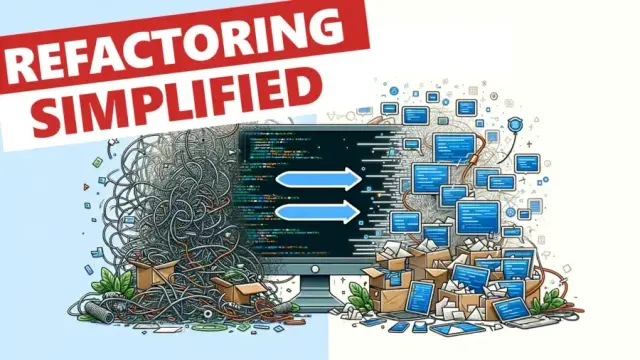So, hier hat der Regen jetzt Scheinbar aufgehört. Den Rest #refactoring mache ich morgen. Interessanterweise ist jetzt passiert, was wir alle schon lange befürchtet haben: ich will morgen mein erstes eigenes #vimscript für #vim und #neovim #nvim versuchen zu schreiben!
#refactoring
Mit der Betonung als Indiana Jones aus dem Abwasserkanal steigt und sagt: "ahh - Venedig!": #refactoring an einem Freitag Abend - Spaß, Spaß, Spaaaaß!
Slow builds? Messy dependencies? CI dragging you down? Learn how modern tools and techniques like containers, smart CI, and incremental #refactoring can streamline your #embedded development workflow. Read more: #CodeEfficiency #SoftwareEngineering
https://www.kdab.com/streamlining-development-by-mastering-modern-development-practices/
Last month, GitClear published an analysis of 211 million lines of code in its AI Copilot Code Quality report. One of the key findings is that #refactoring signals are crashing while #code duplication and churn is increasing.
https://thenewstack.io/whats-missing-with-ai-generated-code-refactoring/
The situation changed slightly after fixing tests, manual testing, and bug fixing.
#SoftwareDevelopment #bugfixing #refactoring
Refactoring can work wonders for simplifying code
Read more here:
https://www.devleader.ca/2023/12/04/how-to-simplify-your-code-with-effective-code-refactoring/
There comes a time in every developer's life where we're faced with this...
Read more here:
https://www.devleader.ca/2023/11/27/refactoring-legacy-code-what-you-need-to-be-effective/
How do you know when to rewrite it all instead of refactor?
Read more here:
https://www.devleader.ca/2023/11/26/rewriting-vs-refactoring-code-how-to-navigate-the-two/
In this #devlog I start by refactoring my spawning code to improve the gameplay. I introduce a bug, finally fix it and then move onto audio. I build a simple audio manager to handle both sound effects and music in one centralised place. https://youtu.be/94Xx39KBUF0 #gamedev #gameaudio #refactoring #unity
🚀 Wow, who knew that #coding while chugging Red Bull and vibing to Spotify could be so groundbreaking? 🎶 But surprise, surprise—turns out the real magic trick is "vibe #refactoring," AKA fixing your 💩 code so you can actually get paid. 💸 Apparently, the real "jazz" happens in the #cleanup crew. 🧹
https://dawidmakowski.com/en/2025/04/vibe-coding-is-fun-but-vibe-refactoring-pays-the-bills/ #vibes #vibe #creativity #HackerNews #ngated
When should we refactor code?
Read more here:
https://www.devleader.ca/2023/11/24/when-to-refactor-code-how-to-maximize-efficiency-and-minimizing-tech-debt/
Why I’m Not Ready to Abandon JavaScript for “Faster” Languages, by (not found on Mastodon or Bluesky):
In this #devlog I implement a lives system, introduce a crash bug, then fix it & create a web playable version of the game. Next I begin work on a pickups system to score points by collecting food and streamline the entire codebase by #refactoring to use the #Unity event system. https://youtu.be/hrbINTjkdbo #gamedev #buildinpublic #cleancode
Test-Driven Development can be considered as reducing your WIP (Work-In-Progress) at a microlevel. By focusing on writing just enough code to make a failing test pass, refactoring what you added and push to source control, we minimise the amount of unexecuted code (= WIP). Limiting WIP is essential for fast software delivery.
I find that the issue Kent Beck talks about here:
https://tidyfirst.substack.com/p/why-tdd-doesnt-lead-to-dumb-code
... is very fundamental to TDD and centers around a couple of commonly missed aspects of it (even though they are spelled out in Test Driven Development by Example)
1- When passing the test, there is a Fake It approach you can take if you don't see the Obvious Implementation right away before you move on to Triangulation and add more tests.
2- When you are using Fake It, the Refactoring step is not primarily about making the code "nicer", but generalizing by removing the duplication between the test and the production code. This is only refactoring in the sense that you are staying green. That's why the step is not optional and getting to green using the simplest, naive implementation is a core part of the process.
I think not using Fake It is one of the two main reasons people fail with TDD (the other is not making writing more testable code a design goal.)
Medior PHP https://leanpub.com/b/mediorphp by Joseph Kanyo is the featured bundle of ebooks 📚 on the Leanpub homepage! https://leanpub.com #Php #Databases #Mysql #ComputerProgramming #Laravel #Symfony #Html #Refactoring #Apis #ApiDesign #books #ebooks
Spent 2 hours yesterday do to a refactoring and cleanup of template files for Cloudhiker. 2 hours very well invested, because the structure is clearer now and I'll spend fewer time searching for specific files.
#coding #refactoring
What is refactoring, why is it important and how can you get really good at it? In this Making Tech Better podcast episode, I spoke to @emilybache about enhancing the skills and culture of your teams, to make your code easier to understand and cheaper to modify.
You can listen here (subtitles on screen): https://youtu.be/ZcEz8cA017M?si=tYhdCbp851oiyLSz








